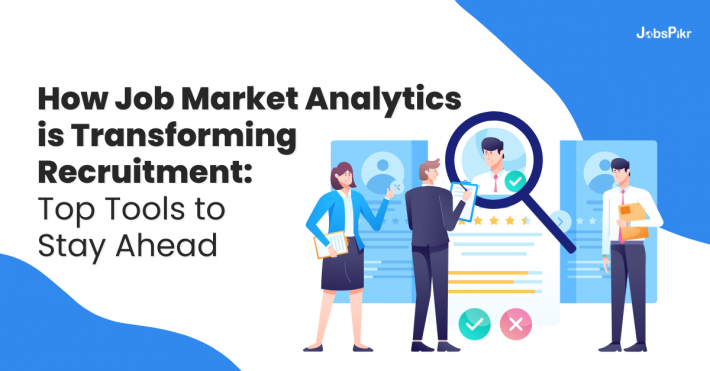Recruitment strategies need to be agile and data-driven during this fast-paced evolving job market. One of the most transformative elements reshaping recruitment is job market analytics. By leveraging data to understand trends, candidate availability, and skill demand, recruiters can optimize their strategies and make more informed decisions. This article delves into how job market analytics is revolutionizing recruitment and highlights the top job market analytics tools that can help you stay ahead of the competition.

Source: LinkedIn
The Transformative Impact of Job Market Analytics
- Uncovering Job Market Trends
Job market analytics provide a deep dive into current and emerging trends within the labor market. This involves analyzing data from job postings, industry reports, and hiring patterns. These insights allow recruiters to identify high-demand skills, new roles, and industry-specific hiring surges. For example, analytics can reveal a growing demand for data scientists or a decline in traditional roles due to automation. Understanding these trends enables recruiters to adjust their strategies and focus on the most pertinent areas.
- Insights into Candidate Availability
One of the primary challenges in recruitment is pinpointing where and how to find the right candidates. Job market analytics tools offer detailed insights into candidate availability, including geographic distribution, skill sets, and job-seeking behavior. This information is crucial for targeting recruitment efforts effectively. For instance, if analytics indicate a high concentration of software engineers in a particular city, recruiters can intensify their outreach in that region to tap into the talent pool.
- Anticipating Skill Demand
Industries and technologies are constantly evolving, leading to shifts in the skills landscape. Job market analytics help recruiters anticipate these changes by analyzing job posting trends and industry forecasts. This foresight allows companies to prepare for future needs by investing in employee training and adjusting hiring criteria to prioritize emerging skills. For example, the rise of artificial intelligence and machine learning has created a significant demand for professionals skilled in these areas, and job market analytics can help recruiters stay ahead of such trends.
- Optimizing Recruitment Strategies
Data-driven insights from job market analytics enable recruiters to refine their strategies for better outcomes. By analyzing which channels yield the best candidates, what job descriptions attract the most interest, and what compensation packages are competitive, recruiters can optimize their efforts. For example, if analytics show that certain job boards generate higher quality applications, recruiters can focus more resources on those platforms. Additionally, understanding salary trends helps in crafting attractive offers that align with market standards.
Top Job Market Analytics Tools to Stay Ahead
1. Jobfeed by Textkernel
Jobfeed is a leading job market analytics tool that aggregates and analyzes job postings from around the world. It provides real-time data on job market trends, in-demand skills, and employer activity. Recruiters can use Jobfeed to identify talent gaps, track competitor hiring activities, and understand market dynamics. This tool is particularly useful for gaining insights into specific industries and geographic regions.
2. JobsPikr
JobsPikr is an advanced job market analytics tool that provides real-time labor market data and insights from job listings across the globe. It helps recruiters and HR professionals stay informed about job market trends, skill demand, and industry-specific hiring patterns. With JobsPikr, recruiters can access comprehensive analytics on job postings, understand the competitive landscape, and make data-driven decisions to optimize their hiring strategies. The tool is particularly useful for identifying emerging roles and anticipating future skill requirements.
3. CEB TalentNeuron
CEB TalentNeuron (now part of Gartner) is a robust job market analytics tool that offers data on global talent markets, competitive intelligence, and workforce trends. The platform provides insights into talent supply and demand, compensation benchmarks, and industry-specific hiring trends. Recruiters can leverage this information to make informed decisions about sourcing strategies, talent acquisition, and workforce planning.
4. Joberate
Joberate uses advanced data analytics and machine learning to provide real-time insights into job seeker behavior and job market trends. The platform tracks online activity to identify potential job seekers and understand their career interests. Recruiters can use Joberate to target active and passive candidates more effectively, optimize job postings, and stay ahead of market shifts.
5. Textio
Textio is an augmented writing platform that uses data analytics to improve job descriptions and other recruitment-related content. By analyzing millions of job postings, Textio provides insights into what language attracts the best candidates, enhances diversity, and improves response rates. This tool helps recruiters craft compelling job postings that resonate with the target audience and drive better engagement.
6. SeekOut
SeekOut is a talent intelligence platform that provides deep insights into candidate availability, skills, and diversity. The tool uses AI and data analytics to help recruiters find and engage with candidates across various channels. SeekOut also offers analytics on market trends and competitor hiring activities, enabling recruiters to stay ahead in the talent acquisition game.
7. Pymetrics
Pymetrics leverages neuroscience-based assessments and AI-driven analytics to match candidates with roles that suit their cognitive and emotional traits. This tool provides insights into candidate potential beyond traditional resumes and qualifications, helping recruiters make more informed hiring decisions. Pymetrics also offers analytics on job market trends and skill demand, ensuring recruiters are well-informed about the evolving talent landscape.
8. TalentBin by Monster
TalentBin is a powerful recruitment tool that leverages data from social media, professional networks, and other online sources to provide comprehensive insights into candidate availability and skills. Recruiters can use TalentBin to discover passive candidates, understand their career interests, and engage with them effectively. The tool also offers analytics on market trends and skill demand, helping recruiters stay ahead in the competitive talent market.

Benefits of Using Job Market Analytics Tools
- Data-Driven Decision Making
The primary benefit of using job market analytics tools is the ability to make informed, data-driven decisions. These tools provide a wealth of information that goes beyond gut feelings or anecdotal evidence, leading to more effective and efficient recruitment processes. Recruiters can reduce time-to-hire, improve the quality of hires, and make strategic decisions that align with market trends.
- Competitive Advantage
Organizations that leverage job market analytics gain a significant competitive edge. By understanding job market dynamics and candidate behavior, recruiters can craft more attractive job postings, offer competitive compensation, and target the right talent pools. This advantage is crucial in today’s competitive labor market, where the demand for top talent is high.
- Enhanced Candidate Experience
Job market analytics also play a vital role in enhancing the candidate experience. By understanding what candidates are looking for, recruiters can tailor their communication and engagement strategies. For instance, if data indicates a preference for flexible work arrangements, highlighting these aspects in job postings can attract more candidates. A positive candidate experience not only improves application rates but also enhances employer branding.
- Strategic Workforce Planning
Strategic workforce planning is another critical benefit of job market analytics. By predicting future skill needs and labor market shifts, organizations can proactively address talent gaps. This involves upskilling existing employees, adjusting hiring criteria, and planning for future recruitment needs. With job market analytics, organizations can ensure they are well-prepared for changes in the labor market and maintain a competitive edge.
Conclusion
The recruitment landscape is being transformed by the power of job market analytics. By harnessing data-driven insights, recruiters and HR professionals can gain a comprehensive understanding of job market trends, candidate availability, and skill demand. This information is invaluable for optimizing recruitment strategies, staying competitive, and making informed decisions. The top job market analytics tools mentioned in this article, such as Jobfeed, TalentBin, CEB TalentNeuron, and JobsPikr, provide the necessary data and insights to navigate the complexities of talent acquisition. As the job market continues to evolve, job market analytics will remain a critical tool for success.
Sign-up now with JobsPikr and get exclusive access to job market analytics and take your hiring process to the next level.




